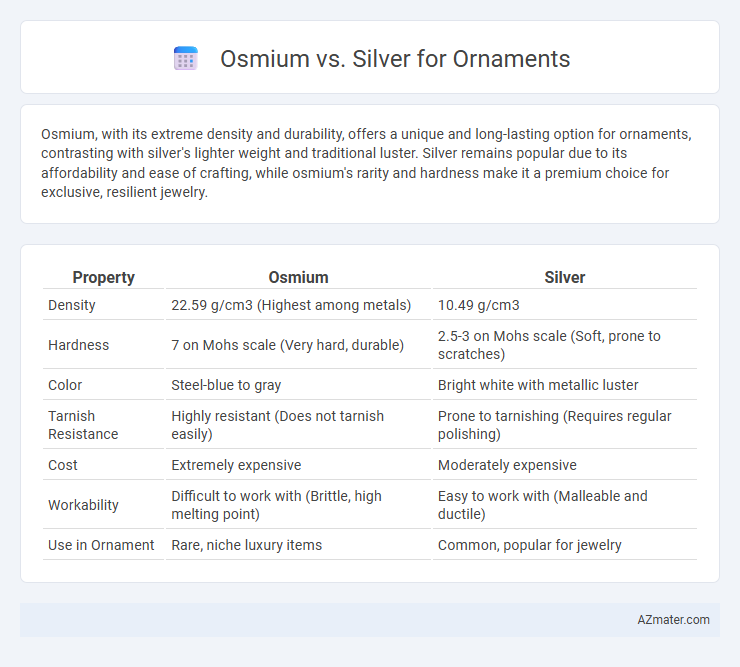Osmium, with its extreme density and durability, offers a unique and long-lasting option for ornaments, contrasting with silver's lighter weight and traditional luster. Silver remains popular due to its affordability and ease of crafting, while osmium's rarity and hardness make it a premium choice for exclusive, resilient jewelry.
Table of Comparison
| Property | Osmium | Silver |
|---|---|---|
| Density | 22.59 g/cm3 (Highest among metals) | 10.49 g/cm3 |
| Hardness | 7 on Mohs scale (Very hard, durable) | 2.5-3 on Mohs scale (Soft, prone to scratches) |
| Color | Steel-blue to gray | Bright white with metallic luster |
| Tarnish Resistance | Highly resistant (Does not tarnish easily) | Prone to tarnishing (Requires regular polishing) |
| Cost | Extremely expensive | Moderately expensive |
| Workability | Difficult to work with (Brittle, high melting point) | Easy to work with (Malleable and ductile) |
| Use in Ornament | Rare, niche luxury items | Common, popular for jewelry |
Introduction to Osmium and Silver as Ornament Materials
Osmium and silver are both precious metals used in ornaments, but they differ significantly in rarity, durability, and appearance. Osmium is one of the densest and hardest metals, known for its bluish-silver hue and exceptional resistance to corrosion, making it ideal for long-lasting, high-end jewelry. Silver, treasured for its bright white luster and affordability, remains a popular choice for ornamental pieces, though it requires regular maintenance to prevent tarnishing.
Physical Properties Comparison: Osmium vs Silver
Osmium exhibits one of the highest densities among metals at 22.59 g/cm3, significantly surpassing silver's density of 10.49 g/cm3, which contributes to its substantial weight and durability in ornaments. Osmium's hardness rating of 7 on the Mohs scale outperforms silver's softer rating of 2.5-3, offering better scratch resistance and longevity for decorative pieces. While silver benefits from superior malleability and its natural bright luster, osmium's bluish-silver sheen and remarkable corrosion resistance provide a unique aesthetic and enduring quality for high-end jewelry applications.
Rarity and Availability of Osmium and Silver
Osmium is one of the rarest naturally occurring elements, with a scarcity that significantly limits its availability for ornamental use, making it a unique but uncommon choice for jewelry. Silver, in contrast, is much more abundant and widely available, allowing for broader use in ornaments due to its affordability and ease of acquisition. The rarity of osmium not only increases its exclusivity but also impacts its market price, positioning it as a luxury material compared to the more accessible and traditional silver.
Aesthetic Appeal: Color, Shine, and Luster
Osmium exhibits a unique bluish-silver hue with a high density that imparts a distinctive, subtle sheen rarely found in traditional ornaments. Silver offers a bright, reflective white-metal appearance with a brilliant shine and high luster that enhances its visual appeal in jewelry. The enduring shine of silver contrasts with osmium's rarity and muted brilliance, making silver more popular for vibrant, eye-catching decorative purposes.
Durability and Wear Resistance for Jewelry
Osmium exhibits exceptional durability and wear resistance, making it a highly suitable material for jewelry that requires long-lasting resilience. Its hardness and density are significantly greater than silver, offering superior scratch resistance and maintaining its lustrous appearance over time. In contrast, silver is softer and more prone to tarnishing and scratches, necessitating more frequent maintenance to preserve its shine in ornamental use.
Hypoallergenic Properties and Skin Safety
Osmium is highly valued in jewelry for its exceptional hypoallergenic properties, making it an ideal choice for individuals with sensitive skin or metal allergies. Unlike silver, which can cause irritation or allergic reactions due to its potential nickel content or impurities, osmium is inert and resistant to tarnish, reducing the risk of dermatitis. This rare metal's non-toxic nature and durability ensure long-lasting skin safety and comfort in ornamental use.
Price and Investment Value in Ornaments
Osmium is significantly rarer and denser than silver, making osmium ornaments substantially more expensive and less commonly available in the market. Silver ornaments offer a more affordable entry point for jewelry buyers, with a well-established resale value supported by a large global market and industrial demand. While silver holds steady investment value due to liquidity and universal recognition, osmium's investment potential remains niche, driven by rarity and novelty rather than widespread market acceptance.
Workability and Crafting Techniques
Osmium is significantly harder and denser than silver, making it challenging to work with traditional jewelry tools due to its high melting point and brittleness in certain forms. Silver is highly malleable and ductile, allowing for intricate designs, easy soldering, and a wide range of crafting techniques including engraving, casting, and filigree. While osmium's rarity and durability offer unique aesthetic value, silver remains the preferred choice for ornament creation because of its superior workability and established artisan methods.
Popularity and Trends in Jewelry Design
Osmium is gaining traction in niche luxury markets due to its rarity and distinctive bluish hue, offering a bold alternative to traditional metals. Silver remains highly popular for jewelry design because of its affordability, versatility, and timeless appeal, maintaining steady demand in both casual and formal ornamentation. Trend analysis reveals increasing interest in mixed-metal pieces, where osmium's unique properties complement silver's classic shine, appealing to avant-garde designers and collectors.
Environmental and Ethical Considerations
Osmium, a rare and dense metal, has a significantly lower environmental impact due to its scarcity and minimal mining waste compared to silver, which is more abundantly mined but often involves energy-intensive extraction and harmful chemical use, raising ecological concerns. Silver mining frequently leads to water contamination and habitat disruption, while osmium's limited extraction reduces such risks, aligning better with ethical sourcing practices. Choosing osmium for ornaments supports sustainable luxury by minimizing environmental degradation and promoting responsible resource utilization.

Infographic: Osmium vs Silver for Ornament
 azmater.com
azmater.com